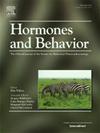Stranger-directed consolation-like behavior in mice in a test of social decision making
IF 2.4
3区 医学
Q2 BEHAVIORAL SCIENCES
引用次数: 0
Abstract
In the past decade, investigations into the neurobiology of empathy have been propelled by evidence that rodents are capable of more complex and nuanced social behaviors than previously believed. Several teams have reported that rodents will direct allogrooming and other consolation-like behaviors towards distressed conspecifics, including in situations in which consolation-like behavior was not the explicit focus of a given study. As a case in point, we unexpectedly found in a test of decision making incentivized by social experience that mice display consolation-like allogrooming towards distressed strangers. This observation was somewhat surprising because consolation-like behavior in rodents is often believed to be reserved for familiar conspecifics. Here in this brief report, we reveal that the allogrooming and close social proximity with a distressed stranger that we previously reported was accompanied by elevated sniffing and autogrooming in close proximity to the conspecific – a social contagion-like behavior. Also, these behaviors were not obviously attributable to general hyper-activity. We then describe the conditions in which this constellation of stranger-directed consolation-related behavior was observed, should this information support new research concerning stranger-directed consolation-like behavior.
在一项社会决策测试中,老鼠在陌生人指导下的安慰行为。
在过去的十年里,有证据表明,啮齿动物能够比以前认为的更复杂、更微妙的社会行为,这推动了对移情神经生物学的研究。几个研究小组报告说,啮齿动物会对痛苦的同种动物进行同种梳理和其他类似安慰的行为,包括在类似安慰的行为不是特定研究的明确重点的情况下。作为一个恰当的例子,我们意外地发现,在一项由社会经验激励的决策测试中,老鼠对痛苦的陌生人表现出安慰性的修饰。这一观察结果有些令人惊讶,因为啮齿动物的安慰行为通常被认为是为熟悉的同类保留的。在这篇简短的报告中,我们揭示了我们之前报道的与一个痛苦的陌生人的异体梳理和近距离社交,伴随着更高的嗅探和近距离自我梳理——一种类似社会传染的行为。此外,这些行为不能明显归因于一般的过度活跃。然后,我们描述了观察到陌生人指导的安慰相关行为的条件,这些信息是否支持关于陌生人指导的安慰类行为的新研究。
本文章由计算机程序翻译,如有差异,请以英文原文为准。
求助全文
约1分钟内获得全文
求助全文
来源期刊

Hormones and Behavior
医学-行为科学
CiteScore
6.70
自引率
8.60%
发文量
139
审稿时长
91 days
期刊介绍:
Hormones and Behavior publishes original research articles, reviews and special issues concerning hormone-brain-behavior relationships, broadly defined. The journal''s scope ranges from laboratory and field studies concerning neuroendocrine as well as endocrine mechanisms controlling the development or adult expression of behavior to studies concerning the environmental control and evolutionary significance of hormone-behavior relationships. The journal welcomes studies conducted on species ranging from invertebrates to mammals, including humans.
 求助内容:
求助内容: 应助结果提醒方式:
应助结果提醒方式:


